Agricultural and Biological Research
RNI # 24/103/2012-R1
Research - (2022) Volume 38, Issue 5
Poor seed establishment threatens the adoption of quinoa as a potential food crop in semi-arid parts of Zimbabwe. We used a 4 × 3 factorial experiment arranged in a Completely Randomised Design (CRD) to establish the effects of irrigation frequencies and different soil types on quinoa germination and early growth. We used three soil types (sand, loam, and clay) and four irrigation frequencies (after every 1, 2, 3, and 4 days). Measurements included days to 50% emergence, germination percentage, mean germination time, germination rate index, and the coefficient velocity of germination, seedling height, final crop stand, and root density. An Analysis of Variance (ANOVA) was done using GenStat 18th Edition and mean separation was done using the Least Significant Difference (LSD) at a 5% significance level. There was an interaction between irrigation frequency and soil type on days to 50% emergence (p<0.05), germination percentage (p<0.05), germination rate index (p<0.05), seedling height (p<0.05), root length density (p<0.05), seedling crop stand (p<0.05). Shorter irrigation frequencies on all soil types had higher final germination percentages than longer irrigation frequencies. Seeds planted in sand recorded the shortest mean germination time (3.25 days), with no significant differences between clay and loam. Sand irrigated at 1-day intervals recorded the highest (70.4%) germination rate index, while other longer frequencies had the lowest. Loam and sand irrigated at 1-day intervals and loam irrigated at 2-day intervals recorded the highest seedling height. Sand irrigated at 2-day and 3-day intervals had the highest root length densities, while clay and loam soil irrigated at 1-day intervals and loam irrigated at 2-day intervals recorded the lowest root length densities. Sand irrigated at 1-day intervals recorded the highest (85%) crop stand. We recommend planting and frequently irrigating quinoa in sandy soils for better crop establishment.
Quinoa production; Water requirement; Soil type; Germination
Introducing domestically grown quinoa (Chenopodium quinoa Willd) in developing countries, especially in Africa, to be part of the diet has great potential to contribute to food and nutrition security [1-3]. As long back as the early 1990s, the potential of quinoa for agro-based African economies was noticed as it was envisaged that the crop could be grown extensively in Africa in response to the growing demands of the crop in Asia, Europe, and the USA [4]. Quinoa has attracted particular attention around the globe because of its health and nutritional benefits, as well as its ability to adapt to different growing environments, which include but are not limited to nutrient-poor, saline soils and drought-prone marginal areas [5-8]. Furthermore, quinoa is a drought-tolerant crop that can grow successfully and produce seed grain even in dry semi-desert conditions that receive an annual rainfall of less than 200 mm [9-12] and even under arid environments [13,14]. Consequently, the crop has thrived in areas susceptible to drought in Africa [7].
The introduction of quinoa in Africa started in the late 1990s in Ethiopia and Kenya [15], Malawi in 2010 [16], and more recently in Zimbabwe in 2017 by the Zimbabwe Resilience Building Fund (ZRBF) [17]. Introducing quinoa in Zimbabwe addresses topical issues on food security, hunger, malnutrition, and poverty in the face of the detrimental effects of climate change and variability. In Zimbabwe, there is a decline in the production of staple food crops such as maize and wheat, which negatively impacts most smallholder farming communities regarding food security and nutrition [18]. In addition, Zimbabwe's food security is continuously being threatened by prolonged dry spells and droughts, especially in semi-arid regions, which are the most affected.
Quinoa production in the country is still in its infancy [17], and the successful rollout and scaling up to more smallholder farmers in marginal areas is being hampered by poor germination, subsequently affecting the final crop stand. Although considered a drought-tolerant crop, the germination and emergence percentage reported by many smallholder quinoa farmers during the initial rollout phase in Lupane and Zvishavane districts of Zimbabwe were as low as 30%. Our preliminary observations motivated this research as the poor germination and crop stand directly affect yield, potential revenue, and quinoa adoption by smallholder farming communities. Unfortunately, there is limited research on the germination and emergence of quinoa in low rainfall or marginal areas.
Therefore, this study aimed to evaluate different water application frequencies on different soil types during early quinoa crop establishment.
Experimental site
The experiment was carried out at the Midlands State University (Zimbabwe) campus in a greenhouse with an average temperature of 33⁰C to mimic the temperature of marginal areas. The site is at 29°84ﹶ E, 19°49ﹶ S, and 1420 m above sea level and falls under the Agro-ecological zone (Natural Region) III of Zimbabwe that receives an annual average rainfall range of 600-750 mm per annum.
Experimental design and treatments
The experiment was set up in a Completely Randomized Design (CRD) and laid out as a 4 × 3 factorial treatment structure with two factors; irrigation frequency and soil type. The irrigation regimes were irrigation after every one day, two days, three days, and four days until the end of the experiment and the soil types were sand, loam, and clay. The treatments were replicated three times.
Experimental procedure
Styrofoam seedling trays (200-cell) were filled with the different soils (sand, loam, and clay). Each treatment comprised 20 seeds replicated three times, watered to field capacity, and left to drain excess water. The different soils were irrigated after skipping one, two, three, and four days.
Soil properties measured
The soils belong to the fersialistic group with dominant kaolinite clay minerals [19].
Bulk density:The initial weight of the core ring was established, and then the soil samples were placed in a drying oven for 24 hours, at 105 degrees Celsius. After 24 hours, the rings were weighed, had their final weight recorded, and then bulk density was calculated using the formula according to Blake [20];

Porosity: Porosity was calculated according to the formula by Hao et al. [21].

Soil pH: The pH was measured using a pH meter, PH TESTER PH-107. Following the procedure by Rayment and Lyons [22], air-dried samples of the three soils were mixed with a diluted concentration of 0.01 M of calcium chloride (CaCl2) at a 1:5 ratio. Twenty (20) grams of each soil was measured, added to a beaker, and then 100 ml of the concentration. The beaker was shaken and left to stand for 20-30 minutes. After that, the pH meter was dipped in the solution while avoiding contact with soil, and readings were collected.
The different soil properties measured are presented in Table 1.
Quinoa growth parameters measured
Days to 50% emergence:The days were recorded when 50% of the seedlings had emerged.
Final Germination Percentage: It was measured up to the point when no more seeds were germinating.
It was calculated as

Mean Germination Time (MGT):The Mean Germination Time (MGT) was established using the equation by Ellis and Roberts [23].

Where n is the number of seeds germinated on day D and D is the number of days counted from the beginning of germination.
Coefficient velocity of germination (CVG): CVG shows rapidity of germination,

Where N is the number of seeds germinated daily and T is the number of days from the seedling responding to N [24].
Germination rate index (GRI):A Germination Rate Index (GRI) to evaluate seedling vigour was determined following the procedure described by Bouton et al. [25] and modified by Fowler [26]. GRI was calculated as:
G2/2 + G4/4 + G6/6 + G8/8
G2, G4, G6, and G8 are germination percentages at 2, 4, 6, and 8 days after sowing.
Seedling height:A 30 cm ruler was used to measure the seedling height after 30 days from sowing. A ruler was placed against the plant, and the height was measured from the top of the soil up to the apical meristem.
Final crop stand:The final crop stand was calculated on the last day of the experiment at six weeks.
Final crop stand=surviving (standing) seedlings/total planted seeds
Root length density:Root Length Density (RLD) is calculated as the total length of the roots, and then divided by the volume of the soil sample [27]:
RLD=LR/V
LR is the length of the roots (cm) and V is the volume (cm3) of the root-permeated soil sample.
Data analysis
Analysis of Variance (ANOVA) was done using GenStat 18th edition, and separation of means was done using the Least Significance Difference (LSD) test at a 5% significant level.
Effects of irrigation frequency and soil type on the number of days to 50% emergence of quinoa seedlings
There was an interaction (p<0.05) between irrigation frequency and soil type on the number of days to 50% emergence. Quinoa planted in sand and irrigated at 1-day intervals was the fastest to reach 50% emergence, emerging in an average of 2.67 days (Figure 1), even though there was no statistical difference between quinoa seeds planted in the sand, clay, or loam irrigated at 1-day and sand irrigated at 2-day intervals. On the other hand, quinoa seeds planted in loam and sand irrigated at 3-day intervals and in loam and sand irrigated at 4-day intervals took the longest to reach 50% emergence.
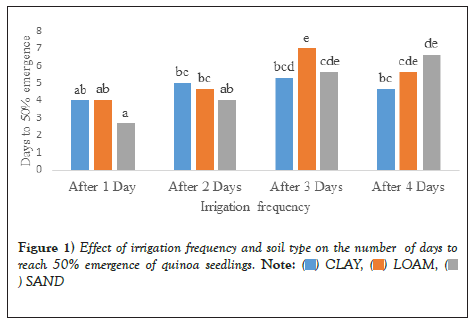
Figure 1: Effect of irrigation frequency and soil type on the number of days to
reach 50% emergence of quinoa seedlings.
 .
.
Effects of irrigation frequency and soil type on final germination percentage of quinoa seeds
There was an interaction (p<0.05) between irrigation frequency and soil type on the final germination percentage of quinoa seeds. Seeds planted in sandy soil and irrigated after 1-day intervals recorded the highest germination percentage of 96.7%, although not significantly different from clay and loam irrigated at 1-day intervals, loam and sand irrigated at 2-day intervals, loam at 3-day intervals and loam at 4-day intervals. In contrast, seeds planted in clay soil and irrigated after 3-day intervals recorded the least germination percentage of 41.7%, although not significantly different from sand irrigated at 3-day intervals, clay and sand irrigated at 4-day intervals (Figure 2). Seeds planted in loamy soil recorded a similar germination percentage across all four irrigation frequencies, averaging 77.5%.
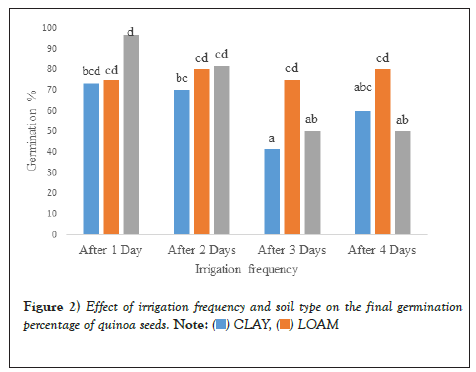
Figure 2: Effect of irrigation frequency and soil type on the final germination
percentage of quinoa seeds. .
.
Effects of irrigation frequency and soil type on mean germination time of quinoa seeds
There was no interaction (p>0.05) between different irrigation frequencies and soil types on the mean germination time of quinoa seeds, nor were there significant differences (p>0.05) in the mean germination time of quinoa seeds between different irrigation frequencies. However, the mean germination time of quinoa seeds was influenced by soil type (p<0.05). The mean germination time was the shortest (3.25 days) in quinoa seeds planted in sandy soil. There was no significant difference in the mean number of days between clay and loam soils, which recorded the longest mean germination time of 4.5 and 4 days, respectively (Figure 3).
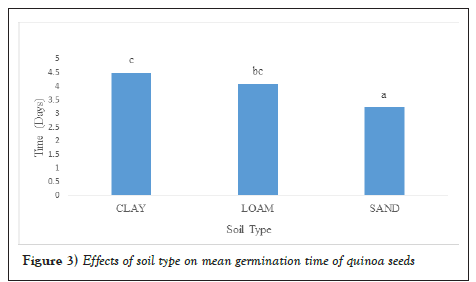
Figure 3: Effects of soil type on mean germination time of quinoa seeds.
Effects of irrigation frequency and soil type on germination rate index (GRI) of quinoa seeds
There was an interaction (p<0.05) between irrigation frequency and soil type on the germination rate index of quinoa seeds. Quinoa seeds planted in sand and irrigated at 1-day intervals recorded the highest GRI of 70.4%. In comparison, those planted in loam soil and irrigated at 3-day intervals recorded the lowest mean GRI of 29.4%, although not significantly different from those planted in clay and loam irrigated at 2-day intervals, sand at 3-day intervals, loam and sand at 4-day intervals (Figure 4). Generally, the GRI of quinoa seeds planted in sand soil decreased as the irrigation intervals increased from one day to four days. On the other hand, there was no statistical difference in GRI on clay soil irrigated at the four frequencies.
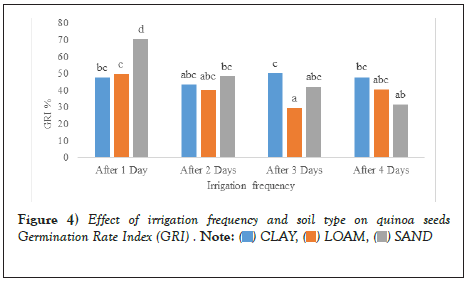
Figure 4: Effect of irrigation frequency and soil type on quinoa seeds
Germination Rate Index (GRI) .
Effects of irrigation frequency and soil type on the coefficient of the velocity of germination of quinoa seeds
There were no treatment effects on the coefficient of the velocity of germination of quinoa seeds (p>0.05).
Effects of irrigation frequency and soil type on the seedling height of quinoa
There was an interaction (p<0.05) between irrigation frequency and soil type at the height of quinoa seedlings. Quinoa seedlings in loam soil irrigated at 4-day intervals recorded the shortest plants averaging 9.3 cm. However, they were not significantly different from quinoa seedlings in sand and clay soil irrigated after 3-day intervals, sand soil irrigated after 2-day intervals and clay soil after 1-day intervals (Figure 4). The tallest seedlings were in loamy soil and sandy soil irrigated at 1-day intervals and loam soil at 2-day intervals (Figure 5).
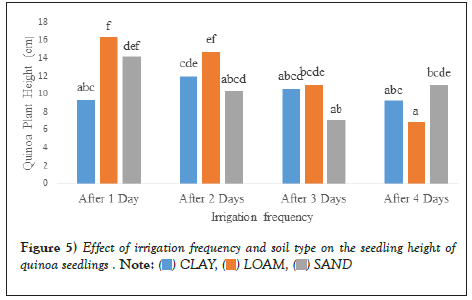
Figure 5: Effect of irrigation frequency and soil type on the seedling height of
quinoa seedlings . .
.
Effects of irrigation frequency and soil type on the final quinoa crop stand
There was an interaction (p<0.05) between soil type and irrigation regime on the final crop stand of quinoa seedlings. The highest quinoa crop stand (85%) was recorded in sandy soils irrigated at 1-day intervals, while all other treatments had statistically similar low crop stands except for loam and sandy soils irrigated at 4-day intervals (Figure 6).
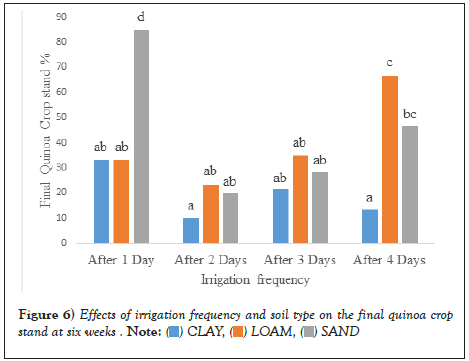
Figure 6: Effects of irrigation frequency and soil type on the final quinoa crop
stand at six weeks . .
.
Effects of irrigation frequency and soil type on root length density of quinoa seedlings
An interaction (p<0.05) between irrigation frequency and soil type on the root length density of six-week-old quinoa plants was observed. Quinoa planted in loam and irrigated at 2-day intervals recorded the lowest root density (3.07 cm/cm3), which was not statistically different from clay and loamy soils irrigated at 1-day intervals. In contrast, those planted in sand and irrigated at 3-day intervals recorded the highest root density of 21.23 cm/cm3 but was not significantly from those in sand irrigated at 2-day intervals (Figure 7). In addition, sand had the highest root density at all irrigation frequencies.
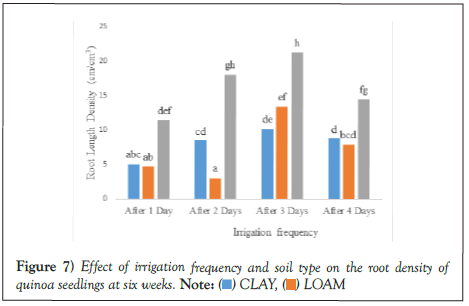
Figure 7: Effect of irrigation frequency and soil type on the root density of
quinoa seedlings at six weeks.
Effects of irrigation frequency and soil type on the number of days to 50% emergence, mean germination time, germination rate index, final germination percentage, and final crop stand
A lower porosity translates to poor soil aeration and seed respiration, which means lower metabolic energy for seed germination [28]. The lowest final germination and final crop stand observed in clay soils (bulk density 0.91 g/cm3 and porosity 0.85) (Table 1) could have been due to seed decay as a result of anaerobic conditions [29]. In sandy soils that were frequently irrigated, the high porosity (0.96) ensured that any excess water drained away and that adequate moisture and oxygen, critical in seed germination and emergence, were available. Thus, lack of adequate water supply in seeds resulted in seeds not germinating, resulting in the decay of some seeds [29]. In addition, the high bulk density of sand (1.2 g/cm3) (Table 1) positively influenced soil moisture and seed-to-soil contact. Lapen et al. [30] explained that these characteristics affect seedling emergence. Lafond et al. [31] also stated that seed-to-soil contact is important where high seedling emergence percentages are desired. Soureshjani et al. [32] also noted that the best seed-to-soil contact occurred at a bulk density of 1.4 g/cm3, giving the best sesame seedling emergence rate. Total porosity that ranges from 0.54-0.96 is commonly accepted in a growth medium for crop cultivation [33]. Our soils were within the acceptable range with values between 0.83-0.96 (Table 1).
| Soil type | Bulk density (g/cm3) | Porosity | pH |
|---|---|---|---|
| Sand | 1.2 | 0.96 | 5.5 |
| Clay | 0.91 | 0.85 | 6.3 |
| Loam | 0.83 | 0.83 | 6.8 |
Table 1: Soil bulk density, porosity and pH results of the soils used in the study.
Effects of irrigation frequency and soil type on quinoa seedling height
Bulk density determines soil water, air, and nutrient retention capacity, while pH determines nutrient availability [34]. Loamy soil had the least bulk density of 0.83 g/cm3, which improved available water capacity, water and air movement in the soil and root growth, increasing plant growth. The pH of the loam soil was 6.8 (Table 1), which is within the optimum range (6.5-8.5) for plant nutrition, as reported by Zucconi [35]. However, quinoa plants irrigated at four-day intervals recorded the shortest seedlings, especially those in sandy soil. This is probably due to water deficit since sand had a high bulk density of 1.2 g/cm3 and a porosity of 0.96 (Table 1), which dried out quickly. Also, the longer irrigation frequency, at four-day intervals, reduced the quinoa height across all soil types. Geerts et al. [36] observed that the pH value increased by decreasing the amount of irrigation water, which negatively affects plant growth as it makes some essential nutrients unavailable by locking them.
Effects of irrigation frequency and soil type on root length density of quinoa seedlings
Numerous studies have reported that water stress or deficit irrigation during the vegetative growth stage triggers root system development of quinoa [37,38]. Under water-stress conditions, plants respond by arresting apical canopy growth and directing attention to developing an extensive root system to support the canopy when water is available. Similarly, Joslin et al. [37] found a significant increase in mass root growth under drier conditions in forest roots. On the other hand, clay and loam soils that were frequently irrigated had the least root densities. Because of their low porosity values of 0.85 and 0.83, these soils probably offered some resistance to root growth; therefore, the root densities under all four irrigation regimes were very poor, as also alluded to by Bengough et al. [38].
The early establishment of quinoa can be linked to soil type and irrigation frequency. Quinoa seeds planted in sandy soils that are frequently irrigated had a high germination percentage, a fast emergence rate, and a good crop stand. Although popular as a drought-tolerant crop, quinoa is sensitive to water stress, particularly during the early growth, especially in porous and well-drained soils. The quinoa seedling grows faster in sandy and loamy soils frequently irrigated. The young quinoa seedlings developed robust root networks in less frequently irrigated sandy soils. Results conclude that in marginal areas solely rain-fed, quinoa establishment should be timed to coincide with the wettest period of the rainy season. If under irrigation, frequent irrigation schedules can be scheduled during the early establishment period.
Although conclusive results can be deduced from the research findings on seed germination, emergence, and early growth from this nursery experiment, further studies can be done as field experiments and see the effects of irrigation frequency and soil types on more growth parameters, yield, and quality of quinoa. Also, different planting depths on the different soils and irrigation types should be investigated to see their impact on quinoa's emergence and early growth in marginal areas.
PC conceptualized and designed the experiment, analysed the data, and wrote the first draft manuscript. CM conducted the experiment, collected and analysed the data, and wrote the first draft manuscript. BMN designed the laboratory protocols and analyzed the soil’s physical properties. VM, IC, TM edited the first draft manuscript to the final manuscript. All authors read and approved the final manuscript.
We thank AgriRxiv for accepting and presenting our manuscript as a preprint under the Creative Commons Attribution (CC BY) license and assigned DOI: 10.31220/agriRxiv.2021.00067.
No funding was received for this research study.
The raw data used to support the findings of this research study will be available from the corresponding author upon a reasonable request.
The authors declare that there was no conflict of interest.
[Crossref] [Google Scholar] [Pubmed]
[Crossref] [Google Scholar] [Pubmed]
[Crossref] [Google Scholar] [Pubmed]
Citation: Chaibva P, Mugala C, Makuvaro V, et al. Irrigation frequency and soil type influence germination and early growth of quinoa (Chenopodium quinoa Willd). AGBIR.2022;38(5):340-344.
Received: 23-Aug-2022, Manuscript No. AGBIR-22-72758; , Pre QC No. AGBIR-22-72758 (PQ); Editor assigned: 25-Aug-2022, Pre QC No. AGBIR-22-72758 (PQ); Reviewed: 08-Sep-2022, QC No. AGBIR-22-72758; Revised: 15-Sep-2022, Manuscript No. AGBIR-22-72758 (R); Published: 23-Sep-2022, DOI: 10.35248/0970-1907.22.38.340-344
Copyright: This open-access article is distributed under the terms of the Creative Commons Attribution Non-Commercial License (CC BY-NC) (http:// creativecommons.org/licenses/by-nc/4.0/), which permits reuse, distribution and reproduction of the article, provided that the original work is properly cited and the reuse is restricted to noncommercial purposes. For commercial reuse, contact reprints@pulsus.com This is an open access article distributed under the terms of the Creative Commons Attribution License, which permits unrestricted use, distribution, and reproduction in any medium, provided the original work is properly cited.
